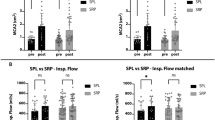Abstract
Septal Correction is an age-old procedure being practiced for the major part of a century now. The aim of this study was to assess the quality of life after Septal Correction. Fifty patients with complaints of nasal obstruction, trouble breathing via the nose, headache and facial pain were selected for the study. Initial pre-operative assessment was done based on a symptomatic score [Nasal Obstruction Symptom Evaluation Scale (NOSE Scale)]. The presence of a septal deviation was confirmed with an X-ray and computed tomography of the paranasal sinuses along with a diagnostic nasal endoscopy. Based on the extent and location of deviation, the malformed part was corrected. Post-operative assessment was done after a period of 8 weeks based on the NOSE Scale. The results were co-related and documented. It was found that the scores were better post-surgery. Thus, it can be concluded that Septal Correction as a surgical procedure is still relevant in today’s World for symptomatic betterment and for a healthier lifestyle.



Similar content being viewed by others
References
Bilal N, Selcuk A, Karakus MF, Ikinciogullari A, Ensari S, Dere H (2013) Impact of corrective rhinologic surgery on rhinogenic headache. J Craniofacial Surg 5:1688–1691
Fettman N, Sanford T, Sindwani R (2009) Surgical management of the deviated septum: techniques in septoplasty. Otolaryngol Clin N Am 42:241–252, viii
Killian G (1905) The submucous window resection of the Nasal Septum. Ann Otol Rhinol Laryngol 14:363–393
Freer OT (1902) The correction of deflections of the Nasal Septum with a minimum of traumatism. JAMA XXXVIII:636–642
Stewart MG, Witsell DL, Smith TL, Weaver EM, Yueh B, Hannley MT (2004) Development and validation of the Nasal Obstruction Symptom Evaluation (NOSE) Scale. Otolaryngol Head Neck Surg 130:157–163
Marro M, Mondina M, Stoll D, de Gabory L (2011) French validation of the NOSE and Rhino-QOL questionnaires in the management of Nasal Obstruction. Otolaryngol Head Neck Surg 144:988–993
Altin F, Haci C, Alimoglu Y, Yilmaz S (2018) Is septoplasty effective rhinogenic headache in patients with isolated contact point between inferior turbinate and septal spur? Am J Otolaryngol. https://doi.org/10.1016/j.amjoto.2019.02.002
Sen I, Dutta M, Haldar D, Sinha R (2017) Estimation of partitioning of airflow in septal surgery: a prospective study with reference to the NOSE scale. Ear Nose Throat J 96(2):E6–E12
Barelli PA, Loch EE, Kern EB, Steiner A (1987) Rhinology: the collected writings of Maurice H. Cottle MD. Warwick. American Rhinologic Society, New York
Floris V, van Zijl WJ, Timman R, Datema F (2017) Adaptation and validation of the Dutch version of the Nasal Obstruction Symptom Evaluation (NOSE) scale. Eur Arch Otorhinolaryngol. https://doi.org/10.1007/s00405-017-4486-y
Lipan MJ, Most SP (2013) Development of a severity classification system for subjective nasal obstruction. JAMA Facial Plast Surg 15(5):358–361. https://doi.org/10.1001/jamafacial.2013.344
Lodder WL, Leong SC (2018) What are the clinically important outcome measures in the surgical management of nasal obstruction? Clin Otolaryngol 43:567–571. https://doi.org/10.1111/coa.13023
Andrews PJ, Jacques T, Nip L, Li CH, Leung T (2017) A UK survey of current ENT practice in the assessment of nasal patency. J Laryngol Otol 131:702–706
Derin S, Sahan M, Deveer M, Erdogan S, Tetiker H, Koseoglu S (2016) The causes of persistent and recurrent nasal obstruction after primary septoplasty. J Craniofac Surg 27:828–830
Hsu HC, Tan CD, Chang CW, Chu CW, Chiu YC, Pan CJ, Huang HM (2017) Evaluation of nasal patency by visual analogue scale/Nasal Obstruction Symptom Evaluation questionnaires and anterior active rhinomanometry after Septoplasty: a Retrospective one-year follow-up cohort study. Clin Otolaryngol 42:53–59
Eren SB, Tugrul S, Dogan R (2014) Objective and Subjective evaluation of operation success in patients with nasal septal deviation based on septum type. Ann. J. Rhinol. Allergy 28:158–162
Author information
Authors and Affiliations
Corresponding author
Ethics declarations
Conflict of interest
There were no conflicts of interest in the conduct of this study.
Informed Consent
We have received a written consent from every patient with respect to Anaesthesia administered, procedure and also the risks and benefits were explained in detail.
Additional information
Publisher's Note
Springer Nature remains neutral with regard to jurisdictional claims in published maps and institutional affiliations.
Rights and permissions
About this article
Cite this article
Muthubabu, K., Srinivasan, M.K., Thejas, S.R. et al. Quality of Life in Patients with Nasal Septal Deviation After Septal Correction. Indian J Otolaryngol Head Neck Surg 71 (Suppl 3), 2219–2224 (2019). https://doi.org/10.1007/s12070-019-01689-9
Received:
Accepted:
Published:
Issue Date:
DOI: https://doi.org/10.1007/s12070-019-01689-9



